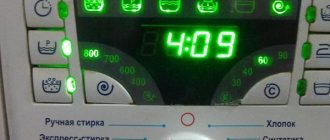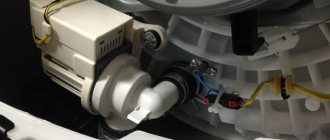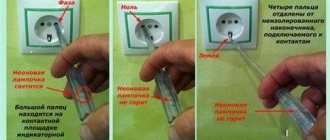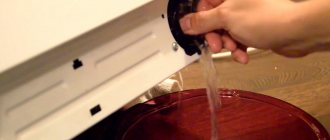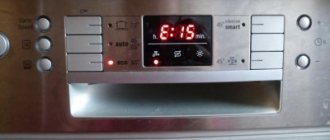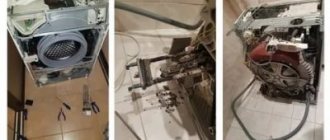Currently, no one doubts the benefits and convenience of dishwashers. These relatively compact household appliances have become an indispensable assistant in any kitchen, no matter the kitchen of a large family, a single bachelor, a business woman or a pensioner. You get used to good things quickly, and when suddenly the dishwasher doesn’t perform its functions, in particular, it doesn’t heat the water, resulting in unsatisfactory washing results, it’s time to sound the alarm.
Note that this breakdown is most often associated with a malfunction of internal elements: heating element, sensors, control module, so repairing a dishwasher can cost a pretty penny. But if you have at least minimal skills and want to save money, you can replace components yourself, especially since service center specialists will charge at least 1000-2000 rubles for providing such services.
The dishwasher does not heat the water - expert advice
The dishwasher does not heat the water. What needs to be done to find a breakdown, the repairman advises. Let's start from the beginning to understand the situation. Today, there are two main types of dishwashers based on the type of water used:
- With connection to cold water supply only.
- With connection to both cold and hot water supply.
Dishwashers with hot water connections are rare in Russia and the CIS. First, they are more expensive because they have an expensive mixing and water temperature control system. Secondly, they use more expensive hot water, which significantly affects utility bills. Such cars are not particularly popular in the Russian Federation.
Dishwashers with cold water supply independently heat the water to the temperature set by the program. Water heating is provided by a heating element in the machine itself. He is not visible, he is not in the tank. It is hidden in the machine's hydraulic system and is inaccessible to the user.
Features of the pressure sensor
The main purpose of this unit is to control the circulation of water in the machine. If the pressure sensor stops functioning, then continuous circulation of water occurs in the system, which ultimately leads to its automatic drainage. Naturally, the heating element with constant circulation simply does not have time to properly heat the water, and washing is done with cold water. The problem can be resolved by replacing the sensor, although you can try to clean its contacts and check the supply wiring.
As a result, it should be noted that if the water heating has disappeared, there is no need to be alarmed, but by consistently eliminating failure options, identify and eliminate the true cause of the failure.
The water doesn't heat up - what's the problem?
Often there is a problem of cold water in the tank. If the dishwasher does not heat the water, as a rule, this indicates a breakdown of the heating element. But often the heating element is working properly, but the reason lies elsewhere. Sometimes, the water remains cold due to the wrong choice of washing program, or a clogged drain filter. The cost of fixing the problem depends on correct diagnosis.
So, the main reasons for the lack of water heating are:
- Breakage of the heating element.
- Thermostat failure.
- Damage to the control unit (popularly called “brains”).
Breakage of heating element
If the heating element breaks down, it should be replaced with a new one. Heating elements cannot be repaired and if they burn, they cannot be restored. Before rejecting the heating element, you should check its contacts. It happens that they oxidize due to overheating and become covered with plaque.
Some craftsmen recommend using copper paste when connecting the heating element. It is used to carefully lubricate the contacts of the heating element so that the paste does not get on anything else. Lubricate lightly to avoid even the slightest contact with other parts of the heating element or dishwasher. Then put on the terminals
wires Copper paste will adhere to the contacts and protect them from plaque formation and loss of contact. Also, you should check the wiring itself that powers the heating element.
Thermostat failure
Why doesn't the dishwasher heat the water? Thermostat failure is the second possible reason for the lack of water heating. It is diagnosed only after the heating element has been tested and its performance has been confirmed. You can check the thermostat only by removing it and measuring its resistance at different temperatures of the thermostat housing.
Each thermostat has its own values. You need to search for them on the Internet for each thermostat model separately.
Before taking measurements, the sensor contacts should be cleaned until shiny. If the sensor is faulty, it is replaced with a new one. Before installing a new thermostat, you should check its wiring. If the wire contacts are oxidized, they need to be replaced.
Dishwasher thermostat.
Control unit failure
If the thermostat and heating element are in order, you need to check the control unit itself. It is impossible to diagnose this part at home. To do this you will need a diagnostic scanner. But you can visually inspect it. Perhaps some contacts are burnt, and you can replace them yourself. If everything is visually in good order, but the control unit does not work, then only an experienced electronics engineer can repair it.
How to determine what exactly is broken?
Before you begin repairing the PMM, it is necessary to accurately determine the source of the problem.
First of all, you need to check the heating element . This is the most loaded unit, which refers to consumable items that require replacement when they fail.
As a rule, resistance is measured using a tester. If the device shows an infinitely high value, it means that the heater has burned out and needs to be replaced.
If the resistance is within normal limits (its value is usually indicated in the passport or instructions for the PMM), check the thermostat and the control unit itself.
The thermostat (temperature sensor) is checked in accordance with the design of the element . Usually these are thermistors, so you need to measure their resistance at room temperature, and then heat the element (just hold it with your hands). If the sensor is working, the resistance will change.
A faulty control module is the easiest to determine. It is never expressed only in the absence of heating; almost all functions of the machine fail.
Errors begin to appear, programs are launched and immediately reset. These signs indicate problems with the electronics.
The video will tell you how a dishwasher works and what breaks in it:
Everything is technically correct, but the water is still cold
In addition to these malfunctions, the reason for the lack of heating of water in the dishwasher may also be a clogged problem. The machine cannot fill and drain water on time, water does not circulate well between the dishwasher tanks. Because of this, glitches in the program may occur and the machine will not work as expected.
In order to check if the drains are clogged, you need to visually inspect them, remove the filters and clean them well.
To check, you can open the dishwasher door slightly during operation. The program will pause. You need to pay attention to whether water accumulates at the bottom of the tank. Ideally, it should not accumulate. If there is water at the bottom, and clearly more than usual, then you should clean the drains of the machine.
To prevent the machine from clogging, it should be used with special cleaning chemicals. It helps both to better wash the dishes themselves and to avoid clogging the drains of the machine. It is also recommended to run a long wash program once a month in an empty car using a special washing gel or powder.
Clearing a clogged filter
To access the dishwasher filter, remove the lower dish rack. The filter can be found either in the back corner of the dishwasher tub or around the base of the lower spray arm.
Clearing a clogged filter
Many dishwasher filters come in two parts: a top filter assembly and a bottom filter assembly. Give the top filter a quarter turn clockwise and remove it. Run water through the dishwasher filter to remove most contaminants.
Do not use a wire brush, cleaning pad or anything rough to clean the filter as these materials may damage it.
Specialist recommendation
To prevent the heating element from burning out due to overheating, it must be periodically descaled. To do this, you need to buy anti-scale powder once every two to three months, and run a long washing program with the highest temperature and add this powder without dishes.
Anti-scale powder should not be used for ceramic heating elements. There are many other chemical cleaning agents for this type of heating elements.
Installing a coarse pre-filter on the pipe supplying the machine with water will help to significantly reduce the formation of scale.
In the video: Bosch dishwasher does not heat the water, repair it yourself.
Source
Step-by-step instructions for prevention
The normal operation of the dishwasher depends on the condition of all its components . In order to create the necessary working conditions for them, it is necessary to periodically service the machine and apply preventive measures. Let's take a closer look at them.
Cleaning filters
Despite the requirement to manually remove food residues from dishes, a large amount of small organic matter still penetrates into the machine. These particles accumulate in filters, reducing their ability to pass water. Therefore, periodic inspection and cleaning of filters is required.
Typically, two filters are installed in the PMM - inlet and drainage. Their locations are indicated in the instructions, since the user must clean them periodically.
Removed filters are cleaned with soapy water or soda; limescale can be removed with citric acid. After cleaning, the filters are put back in place.
High-quality household chemicals
The main factor that has a negative impact on dishwasher parts is water.
If it is too hard, contains a large amount of suspensions and small particles, limescale will appear on the surface of the heater and other components.
If cheap household chemicals are used, you cannot expect high-quality and long-lasting work . To maintain the performance and increase the service life of the machine, it is necessary to use specialized products that remove lime deposits and help clean the critical components of the machine.
Correct mode of operation
To keep the machine in good condition, it is necessary to ensure its optimal operating mode. This means not only the correct choice of program, but also the frequency of use and the amount of load.
Loading rates are indicated in the instructions and must be strictly followed. The choice of mode (cycle, program) is made in accordance with the number of dishes, the degree of contamination, and the shape of the items.
Before starting operation, you should carefully study the user manual and understand which programs should be used for certain situations. Proper use of your machine will keep it in good condition for many years.
Find out everything you need to know about dishwasher water in this section.
Reasons why the dishwasher does not heat the water
A dishwasher saves the housewife time and effort. Dirty, sticky dishes after washing are a real disaster. The reasons for poor operation of the unit may be breakdowns inside the equipment or improper operation. Often the problem of dishes not washed to a shine occurs when the dishwasher does not heat the water. And cold water leaves dirty stains on the surface. From this article you will learn about the reasons why the water in the dishwasher does not heat up.
Trouble-shooting
Unfortunately, not all of the above damage can be repaired with your own hands. For example, on the control unit board there are many parts, each of which has a specific set of functions. Only a qualified specialist can find out the cause of the ECU malfunction and make repairs. In addition, special equipment will be required for diagnostics.
Electronic control unit printed circuit board
It’s good that ECU malfunctions are not as common as the defects discussed below.
Checking and cleaning the inlet filter
The water flowing from the taps can hardly be called clean. It contains many impurities, including solid particles of various shapes and sizes. The PMM inlet filter protects equipment from debris that water can spread through internal parts. Connecting additional flow filters at the inlet hoses provides more thorough cleaning of the liquid. These filter elements must be cleaned periodically.
The inlet filter is located at the junction of the inlet hose with the PMM housing
To clean the inlet filter from dirt, do the following:
- Close the shut-off valve, disconnect the inlet hose and drain the water from it.
- Remove the filter and rinse thoroughly under running water.
- Return all the parts to their places.
Similar manipulations must be performed with the flow filter, if you have one installed.
The Aquastop module has worked or broken
Today, most PMM models are equipped with the Aquastop system. If error E15 appears on the display, this means that water has appeared in the pan. The reason may be depressurization of the chamber, water tank, or one of the joints in the area where the hoses or pipes connect.
Aquastop solenoid inlet valve integrated in the inlet hose
Sometimes situations arise when the safety valve located in the inlet hose does not open, although there is no leak in the dishwasher. Such a breakdown can only be cured by replacing the inlet hose along with the built-in nozzle. To find out and eliminate other causes of the malfunction, it is better to call a specialist.
The presented video will tell readers how to replace the inlet hose of the Aquastop system in a Bosch Edition 45 SilencePlus dishwasher:
The door lock or sensor does not work
With such a failure, error code E06 appears on the Bosch and Siemens PMM displays. The breakdown can be determined by ear: if you don’t hear a click when closing the door, you will have to replace the locking device.
Bosch dishwasher lock
To carry out repairs, proceed as follows:
- turn off the power to the dishwasher;
- open the door, unscrew and remove the front facade or panel;
- disconnect the cable and unscrew the screws holding the locking lock;
- remove the device and replace it with a new one.
Sometimes it happens that the cause of the defect lies in the computer, which does not perceive the closing signal or does not open the door at all. If the lock is jammed, do not try to open the door yourself, otherwise you may damage the device. Better call a specialist.
The inlet valve is faulty
Intake valves are rather fragile devices and do not always withstand pressure above 1 MPa, which can rise as a result of water hammer. There are other reasons for failure, one of which, for example, is lack of contact with the control unit (open circuit). The reason could be the ECU itself.
Dishwasher Inlet Solenoid Valve
One of the reasons for valve failure may be a break in the control electromagnet coil. If power is supplied and there are control signals at the contacts, check to see if the part is clogged inside. If yes, remove the valve and clean it from dirt and debris under running water. If it is clean, it must be replaced. This part can be replaced independently.
This video will tell readers how to disassemble the PMM and check the intake solenoid valve:
Cleaning or replacing the pressure switch
A damaged water level sensor causes an unusual situation: water continuously flows into the PMM and is immediately pumped out into the sewer. Why is this happening? The liquid fills the reservoir, but the control unit does not receive the corresponding signal from the pressure switch and continues to keep the fill valve open.
Pressostat housing in a dishwasher, view from the side of the tray
This part can also be replaced independently. Its location is shown in the photo above.
We hope that this article will help readers fix most problems related to water supply with their own hands.
What happens if you use a dishwasher without heating the water?
New models have hot water parameters for any mode. If there is no heating, they turn off after a few minutes and an error code appears on the display. In the code instructions you can find out the reason for the machine stopping.
Without hot water, dishes will only rinse. There will be no disinfection or excellent cleaning. Some machines, according to the instructions, can be connected to hot water through a special inlet hose. In this case, the water flow must have a certain temperature and flow without pressure drops. These conditions are rarely met, so sinks with a connection to a hot channel are not in demand.
Optimal temperature
Modern machines can operate at different temperatures, “adjusting” to the loaded dishes within a given mode. You can only understand which degree is the most effective through experience - try all the programs offered by the manufacturer.
- Standard wash. This is the basic mode, which is available on both cheap and very expensive models. As a rule, the cycle takes place at 50-60 degrees, which ensures fast and effective removal of contaminants.
- Intensive washing. Not all machines can boast of an intensive program in which loaded plates undergo several stages of high-quality cleaning. The water heats up to 60-80 degrees, which allows the machine to clean and completely disinfect dishes. But it is worth understanding that such cleansing is longer and more energy-consuming than the standard cycle.
- Delicate mode. An additional function designed for gentle washing of fragile materials such as porcelain or crystal. Heating is limited to 40 degrees, and the cycle does not take more than 30 minutes. It is also necessary to use special detergents that dissolve at low temperatures and do not contain abrasive substances.
You can more accurately determine the optimal degree by looking at a special temperature sensor, which is provided in most modern units. If the “thermometer” breaks down, it is better to fix the problem quickly, otherwise the machine will not be as practical and effective as before.
Share your opinion - leave a comment
conclusions
To avoid troubles, it is necessary to carefully study the technical values of the unit and operating rules. It is recommended to empty the mechanism once every six months along with cleaning agents. To prevent mold from forming in the car, after finishing washing, leave the bin door open for ventilation. Wipe the rubber seals with a dry cloth. To soften hard water, add special salt. If the dishes are not washed, remain stained and stained, then it is better to call a professional for diagnostics.
Source
Technical malfunctions of PMM and their elimination
Let's start with the simplest thing - checking the intake filter. If water does not flow into the Electrolux, Beko, Krona, or Whirlpool PMMs, the inlet filter is probably clogged. It is located at the junction of the inlet hose with the machine body. Due to the hardness and contamination of the water, the mesh becomes clogged and the flow does not flow into the hopper.
How to proceed:
turn off the tap; disconnect the hose from the body (be careful, there may be water inside); Using pliers (if necessary), remove the filter mesh; rinse the part with warm water or soak for a while in a solution of citric acid.
It is also advisable to install a flow filter. It softens and purifies water. This will help the heating element (heater) last longer without scale.
Problems with Aquastop
Does your Siemens (Siemens), Hansa (Hansa) dishwasher have an Aquastop valve installed? Then the reason that the water does not flow and is not pumped is probably in it. When a leak develops in the hose, the valve is plugged to prevent an accident. The protective mechanism cannot be repaired and must be replaced.
What to do:
- turn off the tap and disconnect the hose;
- look inside: if the valve is pressed tightly against the sides of the hose, that’s the problem;
- unscrew the hose and replace with a new element.
Door lock faulty
The dishwasher door is equipped with a locking mechanism. By electronically locking, the lock prevents possible leakage. Check if you don't hear a click when closing, the lock needs to be replaced.
How to fix the problem yourself:
- remove the plug from the socket;
- open the door and unscrew the screws holding the front panel;
- behind the panel you will see a locking device - unscrew the screws and remove it from its place;
- install a new lock;
- Reassemble in reverse order.
Intake valve broken
Is the supply valve not filling with water? The problem is identified by the buzzing sound of the pump, which is actively working, but the valve does not open, so it does not pump water. This part in the dishwasher is very sensitive to pressure changes: for example, Bosch models are designed for 1 MPa. Therefore, manufacturers recommend installing pressure reducing valves, which will help avoid water hammer.
Damage to the level sensor (pressure switch)
The supply or fill sensor must measure the water level in the tank. How it works? The pressure switch is triggered and sends a signal to the main module to stop the intake. The module sends a command to the intake valve to close. However, if the sensor breaks down, it may give incorrect readings. For example, it signals that not enough water has been pumped. Then the machine takes in more than normal, and this can lead to overflow.
If you notice that the water supply indicator is on (blinking), but there is no flow, it means that the sensor is giving a command that there is already enough in the tank.
How to fix the situation? Replace the pressure switch:
- Disconnect the machine from the network and communications.
- Turn her over on her side.
- Remove the lid from the bottom (if there is one).
- The pressure switch is a plastic box.
- Using pliers, remove the tube from the box.
- Remove two screws.
- Remove the sensor and check for debris.
- To check functionality, measure the contact resistance with a multimeter.
- Install a new element.
The electronic module has failed
The control board controls the processes in the dishwasher, gives commands to parts and assemblies to turn it on and off. If there are problems with the module, you may notice incorrect behavior of the PMM. For example, the “Water” and “End” buttons on the panel are lit. Which indicates an attempt at a fence - and then its end. Therefore, the equipment does not pump water.
Unfortunately, you won't be able to fix the board yourself. But you can inspect it for damage, and then contact the service:
- open the bunker door;
- unscrew the bolts at the ends and back;
- open access inside - there you will see the board.
If you notice burnt wires, contact a technician. There is no need to do anything further to avoid damaging important parts.
Most dishwasher problems can be fixed by yourself. Act consistently and follow our recommendations if your PMM does not fill water. Watch the video on the topic:
Candles and lighter or matches
Candles will come in handy not only when organizing a romantic dinner and themed parties, but also when the lights in the house suddenly go out and all electrical appliances fail. Wax candles will not only help illuminate a dark room, but also create a cozy atmosphere. However, when using candles, you need to keep in mind that carelessness when using them can cause a fire.
If you are still afraid of the high level of fire hazard of these lighting products, then you can use battery-powered candles. They are durable, do not emit a specific aroma and there is no need to clean the candlestick after using them.
Incorrect installation
The lack of water heating on old machines can be explained by various reasons and factors. But if a new device you just purchased does not dry dishes, this indicates one of two problems:
- Manufacturing defects. In this case, you must immediately return the device to the store and ask for a working model or a refund.
- Incorrect installation and connection of the device to a centralized (built-in) water supply system. The first thing to do in such troubles is to review the connection circuit.
Proper connection of the system involves arranging two elbows (smooth bends of the hose): one of them is made at the base, and the second at the junction of the pipe with the siphon. Such bends are necessary to eliminate the siphon effect, i.e. they prevent the possibility of water returning from the sewer pipe to the device.
If there is no normal drainage, the process of liquid circulation in the dishwasher is suspended. As a result, the required degree of warming up will not be achieved and the program will not work correctly.
If the problem is not corrected, the heating efficiency will be insufficient, and the user will begin to complain about the incorrect operation of the heating unit. To troubleshoot problems, you need to review the connection of the machine to the sewer pipe.
Electric shock from the car
With a 99% probability, the heating element is also to blame. It hit him. We remove the thermal element and inspect it. Usually cracks and defects are visible upon visual inspection. You can place the cell in salt water and measure the resistance between one of its electrodes and the salt solution. The presence of conductivity indicates breakdown. However, this measurement method does not always give the correct result. In some rare cases, a broken heating element does not show conductivity.
The cause of burnout or breakdown of the heating element is usually too hard water and neglect to use table salt to regenerate the softener.
Solenoid valve function
The small part plays an important role: it controls the dishwashing process and is responsible for the timely cessation of water flow when the device turns off or this is provided for by the selected program. The part also ensures that the process of draining water begins when the engine is running.
There are two types of dishwasher solenoid valve:
- active;
- responsible for the uninterrupted operation of the device, are triggered in critical situations or at moments specified in the program.
The second type of dishwasher valve is located at the end of the hose through which the liquid is supplied. It can withstand significant loads and pressure drops in the water supply system. The operating valve opens when the machine engine starts. If the device is disconnected from the power supply, there is no voltage.
How to check and repair a temperature sensor and control board
The temperature sensor is a weak element in the design of a dishwasher, especially for Bosch brands. To understand that the temperature sensor has failed and not another part, proceed as follows:
- Arm yourself with tools: a tester (multimeter), screwdrivers and pliers.
- Disconnect the equipment from the water supply and sewer network (be sure to close the taps on the pipes themselves).
- Disconnect the electrical appliance.
- Remove the dish baskets.
- Remove the lower nozzle, the “garbage” filter and the mesh, unscrew the two fasteners that you will find under it.
- Turn the car upside down and remove the fastenings on the sides.
- Disconnect the drain pipe from the block in which the heating element is located and lift the bottom of the PMM upward.
- The sensor is located inside the body of the water heating unit - this design is due to the need to transfer data to the control unit.
- Disconnect the wires from the thermistor contacts.
- Clean the contacts and use a tester to measure the resistance level of the sensor.
- If it becomes clear that the element has burned out, do not install it back, but take it to the store to find a similar one.
- Install the new element in the same way as you removed it - all actions are carried out in reverse order.
In 1 case out of 100, it happens that the heater is working properly (according to the tester), everything is fine with the sensor and the wiring is in order. Checking the system for blockages showed that everything is fine, the pressure is normal, and the machine continues to wash with cold water. What is the reason, what should I do? In this case, there is a high probability of failure of the electronic unit: most likely, not all at once, but a separate part - the triac.
We do not recommend repairing an expensive part yourself. Repairing a board requires electronics knowledge, experience, and special tools. If it fails, you will have to buy a new module, and its cost is often up to half the price of the PMM.

